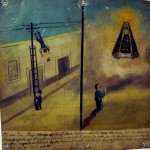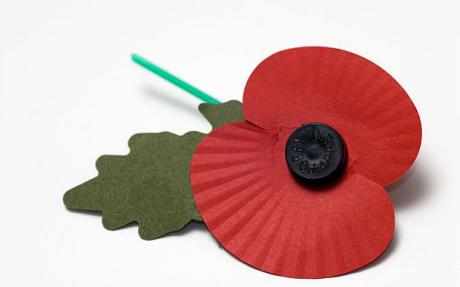Dabblers are strongly urged to visit the Wellcome Collection’s Miracles & Charms exhibition. The photographs above illustrate a few of the hundreds of Mexican miracle paintings on show (click on each photo to read a description of the events depicted, and click again to enlarge the image).
Votive paintings encapsulate the moment when an individual asks a saint for help and is delivered from disaster. Initially on canvas, by the early 19th century images were painted onto cheap tin roof tiles, accessible to all. Hundreds of thousands of these life-affirming amateur artworks line the walls of Mexican churches, with many of the older examples now being housed in museums. The offerings provide a fascinating record of accidents, illnesses and the anxieties of everyday existence.



















Very cool! And surprising that they haven’t all been bought up by Pedlars.co.uk and sold as chi chi trinkets for londoners to put on their kitchen walls…
Now there’s a thought – got any contact details Susan?
Despite the naive, rudimentary nature of these paintings (not unlike some of Tracey Emin’s less naive but equally rudimentary work), I feel they are worthy of more than the odd glib comment. By sharing my photographs of these votives and taking the time to provide descriptions, I was hoping to generate a discussion around the historical and spiritual aspects of this type of art.
Has anyone had a lucky escape from a potentially fatal situation? Have you ever had moments when you prayed? Perhaps during severe turbulence on a lflight? Have you ever thanked your lucky stars you didn’t do something that would certainly have led to instant death? Have you ever expressed your thanks for being alive – either privately, or through some creative outlet. Poetry perhaps? Just a few thoughts…
My comment might seem glib but I was trying to make a point about the appropriation of folk art by people who, inspired by Emin et al, only see it as a piece of bright whimsical decoration when it was created as a very personal and heartfelt thing. In Cornwall the nearest we get to this kind of thing are the trees that people tie ribbons and messages to, mostly in requests for fertility. These pictures are 100 times better. Historically with these Mexican ones, would be interesting to know if these are a strictly Christian thing or whether there’s something much more pagan behind them
So much gets lost in translation on the internet, Worm… The practice of offering ex-votos can be traced back to the Spanish conquest/Catholic heritage, but indingenous rites of sacrifice and thanks must pre-date this. I’m only a Dabbler, so any info from an expert source would be welcome.
The shipwreck picture (top left) is particularly strong. Also really like the hospital scene.
I remember coming on the holy well at Madron some years back, after a lonely tramp across the moors above Penzance, and being quite staggered by the mass of votive offerings — notes, ribbons, toys and trinkets of all kinds — tied to the overhanging bushes. How much of this, I wondered, was testament to a real belief, whether pagan or Christian, and how much tantamount to throwing a few coppers into the ‘wishing well’ in your local shopping mall? As the well at Madron is quite hard to find and get to, I came to think that there had to be at least some belief involved.
Only a few miles from Madron you’ll find the famous stone-with-a-hole-in-it at Men-an-Tol: somehow you wouldn’t need an anthropologist to tell you that this is a fertility symbol. In April 1996 my then girlfriend, now wife, crawled through this three times while a gothy looking woman, who seemed to appear from nowhere, slunk about picking herbs and muttering strange mutterments.
They are now aged 13, 11, and 8.
Yes I like the hospital one. Miracles are performed daily in hospitals but we’re so busy complaining about the NHS and uncaring nurses that we forget this.
Actually these are all terrifically powerful – they cut through the normal veil of adult cynicism to a child’s view of the utter strangeness and wonder of life.
Another question would be whether people painted them themselves or employed a local man who had a sideline in knocking them out to order (perhaps touting for business with his easel on the steps of the church)
Good point Worm, probably Tracey Emin in a past life.
Cornwall is a creepy place, Jonathan – all those spooky old mines, smugglers, folklore… and fog. And it’s so easy to get lost on the moors, no wonder the Corns have some curious beliefs – and mutterings. Thank you for sharing your miracle (I hear Oprah is looking for material for her new show…)
If, Worm, you mean generally rather than specifically in Cornwall, the answer appears to be yes. The wikipedia entry (http://en.wikipedia.org/wiki/Votive_paintings_of_Mexico) – which to a complete ignoramus vis-a-vis this subject appears pretty good and to which I was led by Susan’s fascinating selection – mentions traditional votive painting artists, called “retableros” (retablo being a Spanish name for a devotional painting, as is lamina) and names some, which implies that it is an established profession.
Emotive folk art, if you can’t write about it, paint it, often disturbing Mexican art, and little wonder Mexico city is the strangest place, a cathedral surrounded by 25 million poverty stricken people playing dusty football and a Volvo bus plant, freaked me out. As do Frida’s eyebrows, still, turned ‘ole Diego on, what.